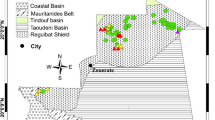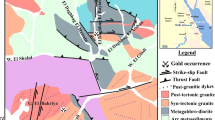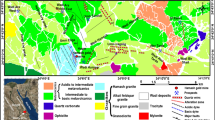Abstract
The Central Gold Belt (CGB) of Malaysia is a major host to gold deposits. Penjom, Raub, Selising and Buffalo reef are major gold mines in CGB. The study area, Selinsing gold mine, is located at the northwest of Pahang province on the lineament known as the Raub Bentong Suture. Presence of dense vegetation and cloud cover in tropical regions are main obstacles in alteration mapping using satellite imageries. In this study, Landsat 8 and ASTER level 1B images were used to map clay minerals and quartz rich zones at Selinsing gold mine and surrounding areas. Direct principal component analysis (DPCA), matched filtering (MF) and band ratio were the effective methods used in this study. High concentration of clay minerals was detected using band ratio 6/7, DPC2 and MF and ratio 14/12 was carried out to highlight quartz rich zones. The results of image processing methods were verified by in situ inspection and X-ray diffraction analyses. The results show that, in spite of limited bedrock exposure, the known gold prospects and potential areas of mineralization can be recognized by the methods employed in this study.









Similar content being viewed by others
References
Abrams, M. (2000). The Advanced Spaceborne Thermal Emission and Reflection Radiometer (ASTER): Data products for the high spatial resolution imager on NASA’s Terra platform. International Journal of Remote Sensing, 21(5), 847–859.
Almeida-Filho, R., & Vitorello, I. (1996). Mapping of hydrothermally altered areas in vegetated terrain, using multisource data integration and segmentation techniques. International Archives Of Photogrammetry and Remote Sensing, 31, 7–12.
Bernstein, L. S., Jin, X., Gregor, B., & Adler-Golden, S. M. (2012). Quick atmospheric correction code: Algorithm description and recent upgrades. Optical Engineering, 51(11), 111719-1.
Boloki, M., & Poormirzaee, M. (2010). Using ASTER image processing for hydrothermal alteration and key alteration minerals mapping in Siyahrud. Iran International Journal of Geology, 2, 38–43.
Campi, M. J., Shi, G. R., & Leman, M. S. (2002). The Leptodus Shales of central Peninsular Malaysia: Distribution, age and palaeobiogeographical affinities. Journal of Asian Earth Sciences, 20(6), 703–717.
Chu, L. H., & Singh, D. S. (1986). The nature and potential of gold mineralization in Kelantan, Peninsular Malaysia. In Geology of Society Malaysian Bulletin, Fifth regional Congress on geology, mineral and energy resources of Southeast Asia (Vol. 20, pp. 431–440).
Crosta, A. P., Sabine, C., & Taranik, J. V. (1998). Hydrothermal alteration mapping at Bodie, California, using AVIRIS hyperspectral data. Remote Sensing of Environment, 65(3), 309–319.
Ducart, D. F., Crósta, A. P., Souza Filho, C. R., & Coniglio, J. (2006). Alteration mineralogy at the Cerro La Mina epithermal prospect, Patagonia, Argentina: Field mapping, short-wave infrared spectroscopy, and ASTER images. Economic Geology, 101(5), 981–996.
Elsaid, M., Aboelkhair, H., Dardier, A., Hermas, E., & Minoru, U. (2014). Processing of multispectral ASTER data for mapping alteration minerals zones: As an aid for uranium exploration in Elmissikat-Eleridiya Granites, Central Eastern Desert, Egypt. The Open Geology Journal, 8(1), 69–83.
ENVI User’s Guide. (2003). Version 4.0.
Feizi, F., Mansouri, E., & Ramezanali, A. K. (2016). Prospecting of Au by remote sensing and geochemical data processing using fractal modelling in Shishe-Botagh, Area NW Iran. Journal of the Indian Society of Remote Sensing, 44(4), 539–552. https://doi.org/10.1007/s12524-015-0510-0.
Fraser, S. J., & Green, A. A. (1987). A software defoliant for geological analysis of band ratios. International Journal of Remote Sensing, 8(3), 525–532.
Galvao, L. S., Almeida Filho, R., Vitorello, I., Epiphanio, J. C. N., & Fonseca, L. M. G. (2005). Use of ASTER short-wave infrared bands for the spectral discrimination of hydrothermally altered-materials: Evaluation in a tropical savannah environment. Simposio Brasileiro de Sensoriamento Remoto, 12(SBSR), 1783–1788.
Glacken, I., Blackney, P., & Murphy, M. (2006). Moncoa Corporation: Selinsing Gold Mining Project, Malaysia Project No. 5174.
Harris, J. R., Rencz, A. N., Ballantyne, B., & Sheridon, C. (1998). Mapping altered rocks using LANDSAT TM and lithogeochemical data: Sulphurets-Brucejack Lake district, British Columbia, Canada. Photogrammetric Engineering and Remote Sensing, 64(4), 309–322.
Harsanyi, J. C., Farrand, W., & Chang, C. I. (1994). Detection of subpixel spectral signatures in hyperspectral image sequences. In Annual meeting, proceedings of American Society of Photogrammetry & Remote Sensing (pp. 236–247).
Hassan, W. F. W., Basori, M. B. I., & Abdullah, I. (2008). Perubahan batuan dinding yang berkaitan dengan pemineralan emas di Selinsing Gold Mine, Pahang [Wall rock alteration related to gold mineralisation in Selinsing Gold Mine, Pahang]. Bulletin of the Geological Society of Malaysia, 54, 75–80.
Hook, S. J., Gabell, A. R., Green, A. A., & Kealy, P. S. (1992). A comparison of techniques for extracting emissivity information from thermal infrared data for geologic studies. Remote Sensing of Environment, 42(2), 123–135.
Hosseinjani Zadeh, M., Tangestani, M. H., Roldan, F. V., & Yusta, I. (2014). Sub-pixel mineral mapping of a porphyry copper belt using EO-1 Hyperion data. Advances in Space Research, 53(3), 440–451.
http://landsat.usgs.gov. U.S. Geological Survey. U.S. Department of the Interior; Updated 2016 Jan 16.
Hunt, G. R., & Salisbury, J. W. (1976). Mid-infrared spectral behavior of metamorphic rocks. Environmental Research Papers Air Force Cambridge Research Labs.
Inzana, J., Kusky, T., Higgs, G., & Tucker, R. (2003). Supervised classifications of Landsat TM band ratio images and Landsat TM band ratio image with radar for geological interpretations of central Madagascar. Journal of African Earth Sciences, 37(1), 59–72.
Iswadi, M. B., Abdullah, I., & Fuad, W. H. (2009). The relationships of structure and deformation to the gold mineralization in Selinsing Gold Mine, Pahang. Geological Society of Malaysia Bulletin, 55, 33–37.
Kujjo, C. P. (2010). Application of remote sensing for gold exploration in the Nuba Mountains, Sudan. Doctoral dissertation: Bowling Green State University.
Lee, A. K., & Sallehuddin, M. (1990). Orientation study on sampling density using heavy mineral stream concentrates for reconnaissance gold exploration in the Selin sing area, Pahang darul Makmur. Proceedings of the 21st Geological Conference. p. 33.
Li, Z. L., Becker, F., Stoll, M. P., & Wan, Z. (1999). Evaluation of six methods for extracting relative emissivity spectra from thermal infrared images. Remote Sensing of Environment, 69(3), 197–214.
Makoundi, C. (2012). Geology, geochemistry and metallogenesis of selected sediment-hosted gold deposits in the Central Gold Belt, Peninsular Malaysia. Doctoral dissertation: University of Tasmania.
Metcalfe, I. (1986). Late Palaeozoic palaeogeography of Southeast Asia: Some stratigraphical, palaeontological and palaeomagnetic constraints. Geological Society of Malaysia Bulletin, 19, 153–164.
Metcalfe, I. (1988). Origin and assembly of south-east Asian continental terranes. Geological Society, London, Special Publications, 37(1), 101–118.
Metcalfe, I. (2000). The Bentong–Raub suture zone. Journal of Asian Earth Sciences, 18(6), 691–712.
Metcalfe, I. (2002). Permian tectonic framework and palaeogeography of SE Asia. Journal of Asian Earth Sciences, 20(6), 551–566.
Molan, Y. E., Refahi, D., & Tarashti, A. H. (2014). Mineral mapping in the Maherabad area, eastern Iran, using the HyMap remote sensing data. International Journal of Applied Earth Observation and Geoinformation, 27, 117–127. https://doi.org/10.1016/j.jag.2013.09.014.
Moore, F., Rastmanesh, F., Asadi, H., & Modabberi, S. (2008). Mapping mineralogical alteration using principal-component analysis and matched filter processing in the Takab area, north-west Iran, from ASTER data. International Journal of Remote Sensing, 29(10), 2851–2867.
Ninomiya, Y. (2003). A stabilized vegetation index and several mineralogic indices defined for ASTER VNIR and SWIR data. In Geoscience and remote sensing symposium, 2003. IGARSS’03. Proceedings. 2003 IEEE international (Vol. 3, pp. 1552–1554).
Okada, K., Segawa, K., & Hayashi, I. (1993). Removal of the vegetation effect from LANDSAT TM and GER imaging spectroradiometer data. ISPRS Journal of Photogrammetry and Remote Sensing, 48(6), 16–27.
Oskouei, M. M., & Babakan, S. (2016). Detection of alteration minerals using hyperion data analysis in Lahroud. Journal of the Indian Society of Remote Sensing, 44(5), 713–721.
Pour, A. B., & Hashim, M. (2011). Identification of hydrothermal alteration minerals for exploring of porphyry copper deposit using ASTER data, SE Iran. Journal of Asian Earth Sciences, 42(6), 1309–1323.
Pour, A. B., & Hashim, M. (2014). Integrating PALSAR and ASTER data for mineral deposits exploration in tropical environments: A case study from Central Belt, Peninsular Malaysia. International Journal of Image and Data Fusion. https://doi.org/10.1080/19479832.2014.985619.
Pour, A. B., & Hashim, M. (2015). Hydrothermal alteration mapping from Landsat-8 data, Sar Cheshmeh copper mining district, south-eastern Islamic Republic of Iran. Journal of Taibah University for Science, 9(2), 155–166.
Pour, A. B., Hashim, M., & van Genderen, J. (2013). Detection of hydrothermal alteration zones in a tropical region using satellite remote sensing data: Bau goldfield, Sarawak, Malaysia. Ore Geology Reviews, 54, 181–196. https://doi.org/10.1016/j.oregeorev.2013.03.010.
Richards, J. A. (1999). Remote sensing digital image analysis (Vol. 3). Berlin: Springer.
Rowan, L. C., Hook, S. J., Abrams, M. J., & Mars, J. C. (2003). Mapping hydrothermally altered rocks at Cuprite, Nevada, using the Advanced Spaceborne Thermal Emission and Reflection Radiometer (ASTER), a new satellite-imaging system. Economic Geology, 98(5), 1019–1027.
Rowan, L. C., & Mars, J. C. (2003). Lithologic mapping in the Mountain Pass, California area using advanced spaceborne thermal emission and reflection radiometer (ASTER) data. Remote Sensing of Environment, 84(3), 350–366.
Salisbury, J. W., Wald, A., & D’Aria, D. M. (1994). Thermal-infrared remote sensing and Kirchhoff’s law: 1. Laboratory measurements. Journal of Geophysical Research: Solid Earth, 99, 11897–11911. https://doi.org/10.1029/93JB03600.
Vaughan, R. G., Hook, S. J., Calvin, W. M., & Taranik, J. V. (2005). Surface mineral mapping at Steamboat Springs, Nevada, USA, with multi-wavelength thermal infrared images. Remote Sensing of Environment, 99(1), 140–158.
Volesky, J. C., Stern, R. J., & Johnson, P. R. (2003). Geological control of massive sulfide mineralization in the Neoproterozoic Wadi Bidah shear zone, southwestern Saudi Arabia, inferences from orbital remote sensing and field studies. Precambrian Research, 123(2–4), 235–247. https://doi.org/10.1016/S0301-9268(03)00070-6.
Yajima, T. (2014). ASTER data analysis applied to mineral resource exploration and geological mapping. Doctorate dissertation: Nagoya University.
Yetkin, E. (2003). Alteration mapping by remote sensing: Application to Hasandag–Melendiz volcanic complex. Doctoral dissertation: Middle East Technical University.
Acknowledgements
The authors would like to express our gratitude to the Department of Minerals and Geoscience Malaysia (JMG) for providing various essential datasets used in this study. And also to Land Processes Distributed Active Archive Center (LP DAAC) for providing ASTER L1B imagery used in this study.
Author information
Authors and Affiliations
Corresponding author
About this article
Cite this article
Ghasemi, K., Pradhan, B. & Jena, R. Spatial Identification of Key Alteration Minerals Using ASTER and Landsat 8 Data in a Heavily Vegetated Tropical Area. J Indian Soc Remote Sens 46, 1061–1073 (2018). https://doi.org/10.1007/s12524-018-0776-0
Received:
Accepted:
Published:
Issue Date:
DOI: https://doi.org/10.1007/s12524-018-0776-0




